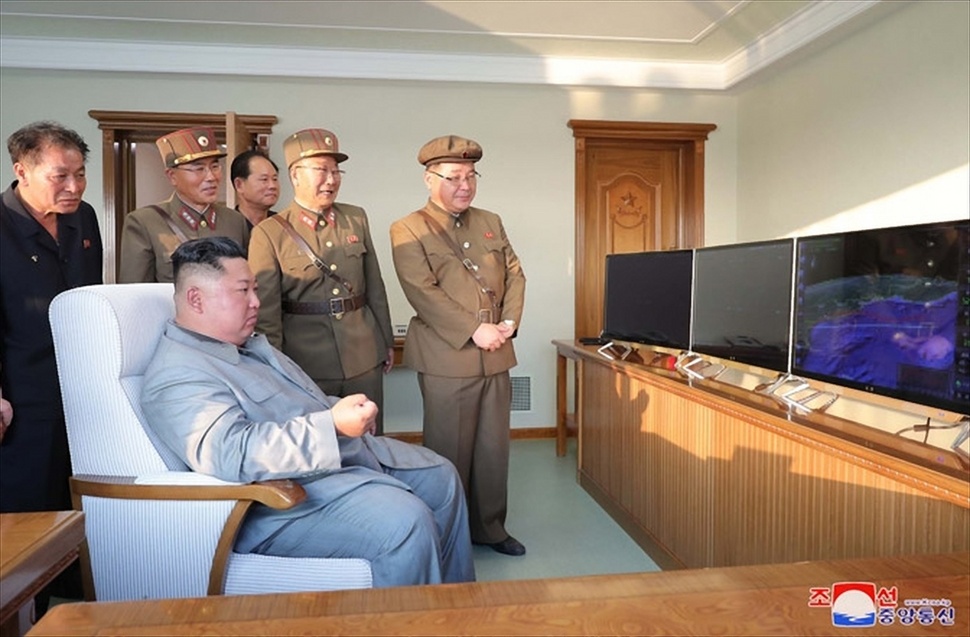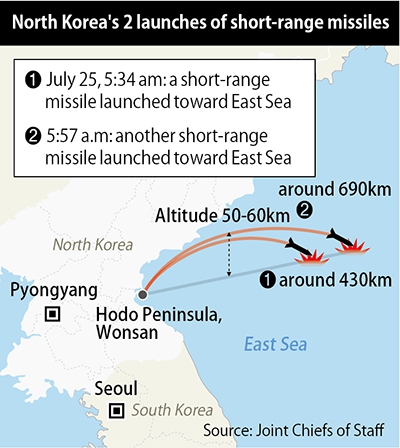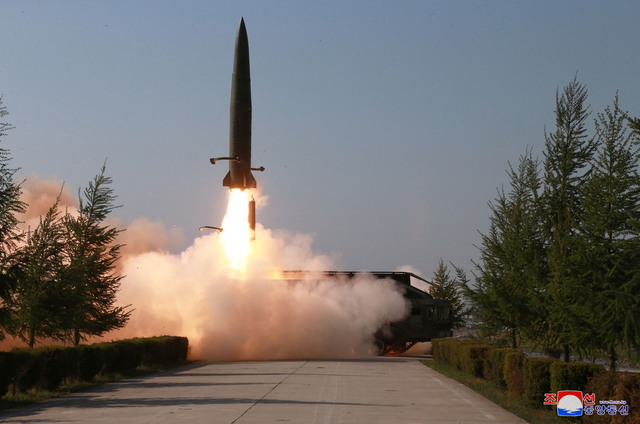Posted on : Jul.26,2019 15:48 KST
Modified on : Jul.26,2019 16:21 KST
 |
|
North Korean leader announced that he personally orchestrated and oversaw a "display of firepower" in response to the upcoming South Korea-US joint command post exercises scheduled for August, the Korean Central News Agency reported on July 26. (Yonhap News)
|
 |
|
North Korea‘s 2 launches of short-range missiles
|
North Korea test-launched two short-range missiles toward the East Sea on July 25. It was its first show of force in more than two months since May, when it launched two other short-range missiles. This sort of military action by North Korea, which undermines the historic significance of the Panmunjom meeting among the leaders of South and North Korea and the US late last month and damages the mood of reconciliation that has been taking shape on the Korean Peninsula, cannot be tolerated for any reason. Pyongyang must immediately stop engaging in actions that raise tensions and agree to working-level talks toward denuclearization.
North Korea is certain to have a thing or two to say about the situation. The claim from Pyongyang is that Washington is planning “exercises for a North Korean invasion,” violating the promise made by the North Korean and US leaders’ in Panmunjom. This is a reference to the 19-2 Dong Maeng joint military exercise planned with South Korea for early next month. The US has denied that such a promise was ever made in President Donald Trump’s meeting with North Korean leader Kim Jong-un. It remains to be determined which side’s version is more accurate – but it is nonetheless difficult to comprehend this upsetting of the apple cart with a show of force less than a month after the three leaders’ meeting.
 |
|
A short-range North Korean missile fired from a transporter erector launcher (TEL) on May 9. (Yonhap News)
|
It seems clear that the North’s military activities are part of a blinking contest, with the aim of shifting the playing field to its advantage before resuming working-level denuclearization talks with the US. Pyongyang has been repeatedly applying military pressure tactics since a Foreign Ministry spokesperson’s statement on July 16 warning that going ahead with the South Korea-US military exercises would have an effect on working-level talks. Ahead of the missile launch, Kim Jong-un also went to inspect a newly built submarine.
The US has been urging North Korea to participate in working-level denuclearization negotiations, while the North continues to bide its time without providing a response. In the meantime, the timeline of “within two to three weeks” for the denuclearization working-level talks as pledged during the leaders’ Panmunjom meeting has passed. Some predicted the ball would start rolling toward negotiations with a meeting between North Korean Foreign Minister Ri Yong-ho and US Secretary of State Mike Pompeo at the ASEAN Regional Forum in Bangkok on Aug. 1 – but an announcement that Ri would not be attending squashed those expectations. At this rate, it’s looking very likely that the working-level talks will be pushed back until after the South Korea-US military exercises in August.
This uncertain state with no fixed schedule for working-level denuclearization talks means that the instability surrounding the Korean Peninsula will only drag on. It’s time that both Pyongyang and Washington took a step back in order to get the negotiations started again. The US needs to switch up its current negotiating methods, while the North can’t go on simply ratcheting up the pressure. Both sides need to take advantage of the significance of their leaders’ historic meeting at Panmunjom by working more actively to establish common ground. The South Korean government, for its part, needs to respond actively to the changing situation, balancing itself in its role as facilitator for the North Korea-US talks.
Please direct comments or questions to [english@hani.co.kr]











